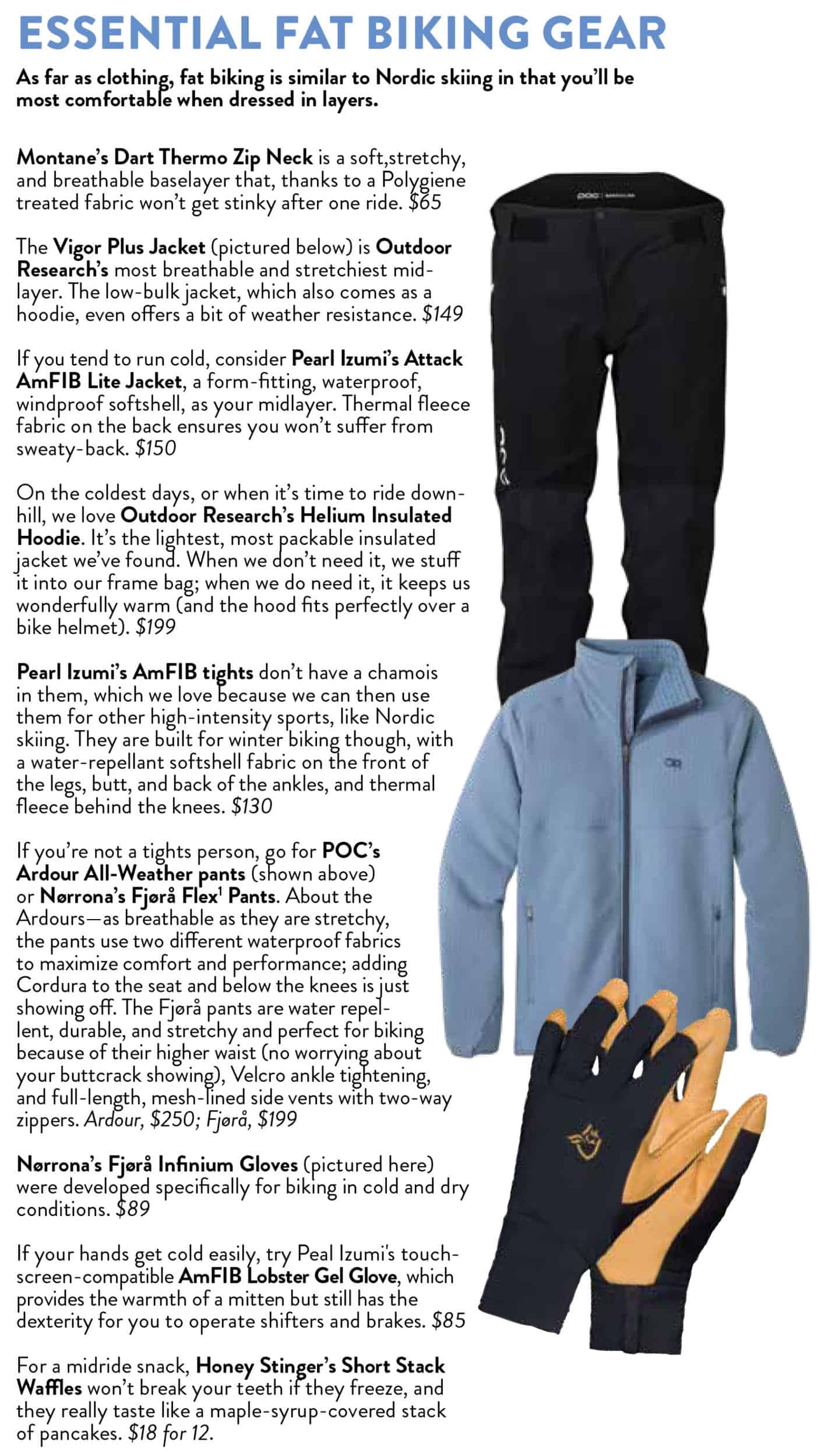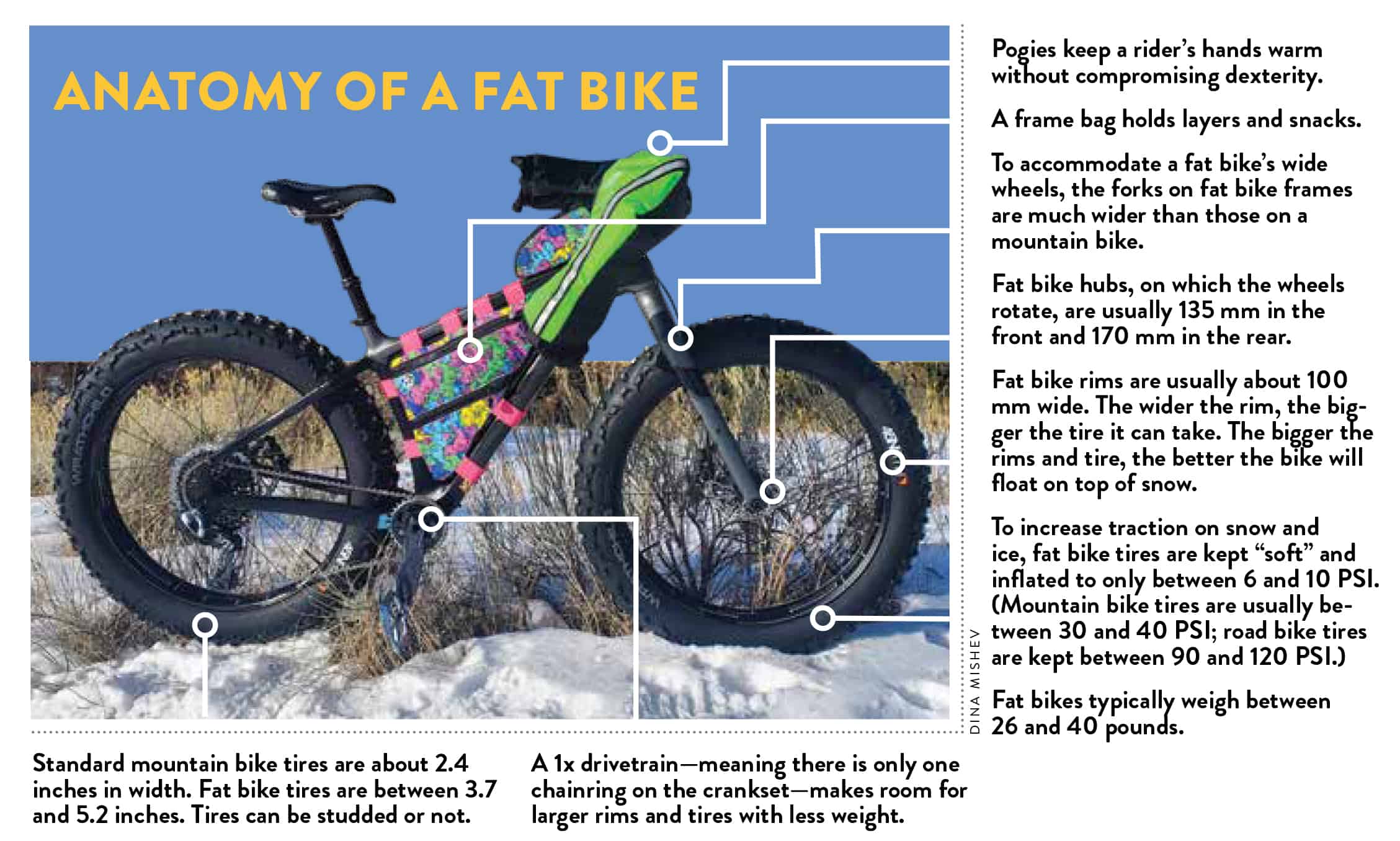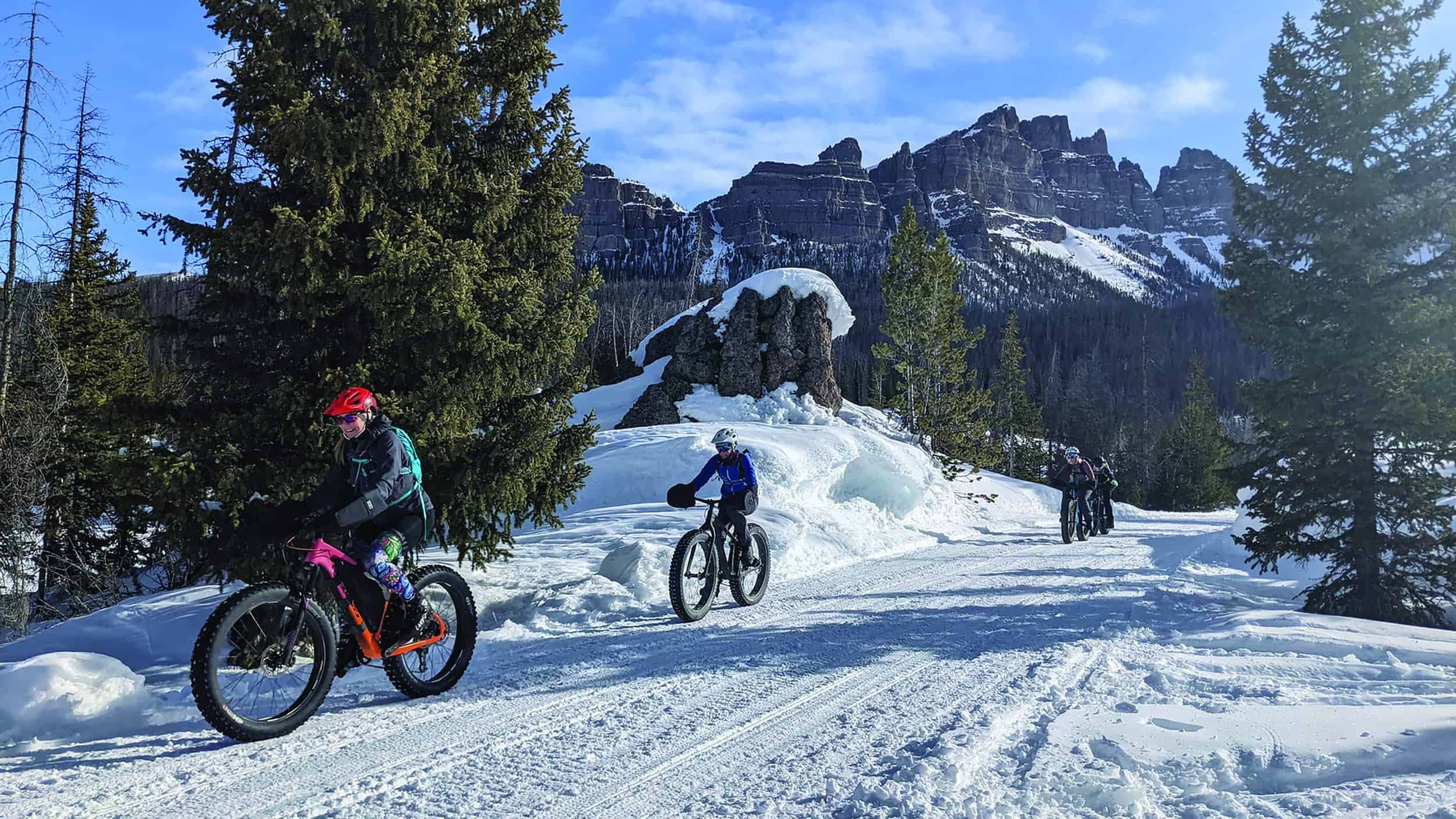Read The
Current Issue
Riders on the Snow
Fat bikes are silly looking, but make for serious fun.
// By Dina Mishev

“Clown bike.” “Cartoonish.” “Ridiculous.” Fat bikes and fat biking have been called all of these things in recent articles in publications as esteemed as the Wall Street Journal, Fortune, and Outside. People love to lampoon the sport, which uses bikes with tires up to five inches wide to ride on packed snow. But, read any article about fat biking through to the end, and you’ll see people also just plain love it.
“I love it for its ridiculousness,” says Kelly Biscombe, who bought her first fat bike last winter. “It is just so fun—it feels like riding on the moon—and it allows me to have a whole season of biking outside that I wouldn’t have otherwise.” And fat biking is easy: the size of fat bike tires makes fat bikes more stable than any other type of bicycle and, unlike mountain biking, basic fat biking requires no technical skills. “It is totally not intimidating,” Biscombe says. “Speeds are much slower than on a road or mountain bike. It’s a fun sport for everyone—it makes me feel like a kid again—and is all about the experience of being outside and experiencing winter in a totally different way.”
Like any sport, fat biking offers a range of adventures—from mellow rides on the valley’s extensive pathway system or on trails groomed for Nordic skiing at Turpin Meadow Ranch to tackling the more difficult singletrack trails around Cache Creek in the Bridger-Teton National Forest or the Mike Harris trailhead near the base of the western side of Teton Pass. In the middle are the groomed trails at Grand Targhee Resort, which include wide trails also used by Nordic skiers and singletrack specifically groomed for fat bikers.
“It is just so fun—it feels like riding on the moon—and it allows me to have a whole season of biking outside that I wouldn’t have otherwise.”
—kelly Biscombe
But, as fun and accessible as fat biking is, it is condition dependent. “The conditions for fat biking are usually good when ski conditions are bad,” Biscombe says. “You don’t want to fat bike when there’s a lot of new snow. Last winter we had a dry spell and I rode every day, but then it snowed and I didn’t touch my fat bike for weeks.” As much as the giant tires float on top of snow, there’s a limit. If there’s too much fresh snow—usually about two inches when there’s a groomed track underneath—you’ll find your tires slipping, the treads unable to get enough purchase. Neither do you want to fat bike when the temperature is above freezing. Slushy trails are more work to ride on, and, most importantly, riding on soft, wet snow ruins the trails for other users like Nordic skiers by creating deep ruts. Almost all areas with shared-use trails have regulations about when fat bikes are allowed; generally these can be summarized as, “if you’re leaving a rut, you shouldn’t be riding.”
Fat bikes are available to rent from valley bike stores, at Grand Targhee Resort, and at Turpin Meadow Ranch. Grand Targhee was the first ski resort in the country to open its Nordic trail network to fat bikers and remains the only resort in the area to allow fat bikes. It now has 10 miles of groomed trails shared by Nordic skiers, fat bikers, and snowshoers and six miles of groomed singletrack trails specifically for fat bikers. Turpin Meadow Ranch, in Buffalo Valley about a one-hour drive north of downtown Jackson, also has about 10 miles of groomed shared-use trails, and six miles of fat biking singletrack trails. Teton Bike Tours (tetonmtbike.com) does half- and full-day guided fat bike tours that include a bike and helmet (the company also offers rentals if you want to explore on your own). Find fat biking trails at JHNordic.com.


A Brief History of Fat Biking
1987: The first Iditabike is held. Minnesotan Dave Zink wins the 210-mile out-and-back race along the first section of the Iditarod sled-dog racecourse. Zink finishes in nearly 34 hours and pushes his bike for half of the distance.
1988: Alaskan Steve Baker welds two standard mountain bike rims together, laces them to four-flange hubs, and mounts a tire on each rim to create a double-wide “tire” measuring 4.4 inches
Early 1990s: Simon Rowaker develops a 1.7” (44mm) wide rim called the Snowcat; it is the largest production rim.
1991: Dan Hanebrink of Hanebrink Bikes develops the Extreme Terrain Bike. It has 20-inch-diameter, 8-inch-wide tires designed to ride on snow, sand, and slickrock.
1996: Ray “Remolina” Molina, an adventure cyclist in New Mexico, cuts two Snowcats up the center and welds in additional aluminum to create 80mm rims. He develops a 3.5-inch-wide tire, the Chevron, and finds a company in Mexico to manufacture both.
1998: Bike manufacturer Surly launches. Making steel bikes exclusively, the company quickly develops a reputation for edgy rides.
1999: Alaskan Mark Groneweld pairs Remolina rims with a custom frame—the first modern fat bike is born.
2000: The first Iditasport Impossible, a 1,000-mile version of the Iditabike (and now called the Iditarod Sport Invitational), is held. The winner completes the course in 15 days.
2005: Surly releases the first mass-produced fat bike, the Pugsley. It has four-inch tires.
2007: Alaska-based Fatback releases fat bikes with symmetrical frames and ultrawide hubs and rims, allowing for better flotation while reducing weight.
2010: Salsa releases its first fat bike, the Mukluk.
2012: Grand Targhee becomes the first ski area in the country to allow fat bikes, conditions permitting, on its groomed Nordic trails.
2013: Salsa releases a carbon-fiber fat bike, the Beargrease. Sales of the ‘grease exceed predications by a factor of four.
2013: A group begins snowshoe packing a couple of miles of the singletrack trails in Cache Creek to demonstrate to the Bridger-Teton National Forest (BTNF) there is a need and desire by fat bikers for grooming.
2014: Fat biking is the fastest-growing market segment in the cycling industry.
2016: BTNF grants local non-profit Friends of Pathways (FOP) approval to officially start grooming singletrack trails in Cache Creek for fat bikers.
2021: FOP earmarks about $5,000 annually for grooming 12 miles of fat biking trails in Cache Creek. This year the nonprofit must also spend about $14,000 on a new snowmachine and grooming attachment. JH





